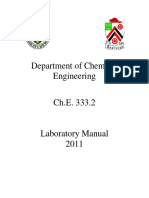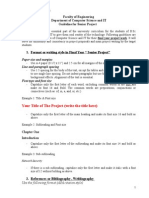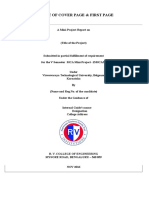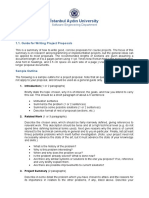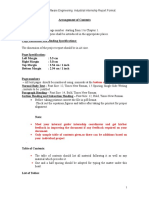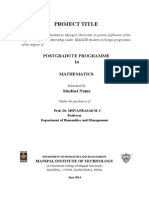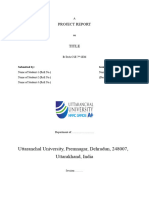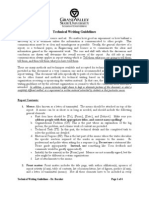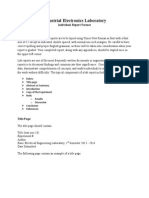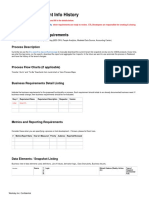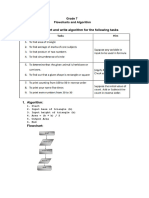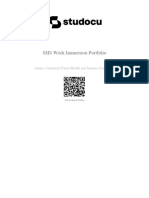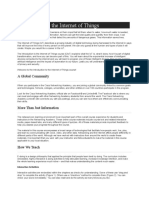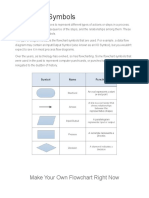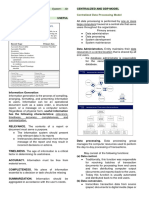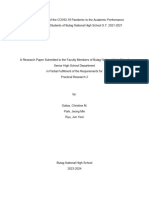01 General Guidelines of Project Report Format
Uploaded by
amrpala01 General Guidelines of Project Report Format
Uploaded by
amrpalaDepartment of Electrical & Electronics, MIT Manipal
Format of Project Report
March, 2013
General
Hard Copies to be prepared: 5 (individual copy (1)), 1 each for guide(int and ext), dept & college) Hard Copies to be submitted: 3 (One to internal guide and 2 in the HODs office) Soft copy (both word and pdf format) to be submitted in cd with project name, students name with register number mentioned on cd cover along with the 2 hard copies in the HODs office Date of submission: You can submit the report starting from May 1st ,provided Minimum TEN months of internship is completed Internal guide is satisfied with the work Atleast one paper presented/ published in conference/ Journal Warning! Avoid plagiarism if found, the report will be rejected. Students will be asked to resubmit the report if it do not comply the format specified. Projects will be extended if the evaluation panel feels that the work done is inadequate.
Format
MSWord or LaTeX Times New Roman, 12 pt, 1.15 line spacing, justified Paper size A4 Margin bottom, right 2.5 cm, top, left 3 cm Page numbers bottom right, continuous, starting from Introduction Chapter Header Title of chapter in italics (shorten if loo long), 8pt, right justified Chapter Titles Centred, Bold, Upper case, 14 pt Section Titles Left justified, Bold, Title case, 12 pt, numbering chapter no. section no (eg. 1.1) Sub-section Titles - Left justified, Bold, Title case, Italics, 12 pt, numbering chapter no. section no. sub-section no (eg. 1.1.1) References, Figures and Table captions 10 pt Number and caption all figures and tables as per IEEE format Give citations for all figures, tables and references in the text of thesis.
Binding
Soft binding (similar to lab instruction manuals, No spiral binding/comb binding) Cover sheet sky blue, printed in black. No of pages About 50 Arrangement of contents
A. Cover page: Title - not very long; ; specific and suggestive of the work carried out (See page 4) B. Inner page: (See page 4, same as cover page) C. Dedication: (Optional) D. Certificate: (See page 5 & 6) Attach the certificate from the company with signature & seal of the external guide if the project work is done at external organisation. . E. Acknowledgement: Max 1 page F. Abstract: About 150 words, highlighting objectives, application issues, innovative aspects, significance of methods, results, crucial conclusions/recommendations. G. Table of contents: Contents to be listed and their page numbers indicated up to a depth of two decimal points only. Eg. 1.1;1.1.1; 1.1.2;1.2;1.2.1 where 1 would be Chapter heading 1.1 would be first level section heading 1.1.1 would be second level sub-section heading eg.., 1. INTRODUCTION 1.1 Problem Definition 1.1.1 Context of use 1.1.2 Functional details H. List of Figures/ Tables/ Symbols & Abbreviation used I. Chapters of the report
1. Introduction
1.1 Problem Statement: What is the product being developed/ problem whose solution is being proposed? (one paragraph) 1.2 Current Status: Literature Survey of available information ; Market and user survey of comparable products. (2-3 pages) 1.3 Motivation for the project: Dissatisfaction with existing solutions on technical or economic grounds; Claim of novelty/ superiority of proposed product or solution. (2 paragraphs) 1.4 Organisation of report: A meta-level statement of the chapters and their content; hints for readers especially interested in some particular aspect of the report. (1 or 2 paragraphs)
2. Design Details/Materials and methods/ Theory/ Principles Note: Introduction & Conclusion can be included for all the chapters.
The exact heading and content will depend on the specific project being described. Conceptual block diagrams, alternative design possibilities, required materials, possible methods of implementation, and theory/ principles of operation of the product/mechanism are points likely to be included in this chapter.
3. Implementation/Methodology
This chapter deals with the actual implementation of the design choices made by the project team and described in Chapter 2. Flow charts, functional block diagrams, circuit diagrams and associated descriptions of structure and function will be given here in the case of hardware projects. Flow charts and Pseudo-codes will be dealt with in the case of software projects. If a project
involves both hardware and software, interface and integration details will be presented in this chapter.
4. Results and Discussion
Testing/Evaluation measures, qualitative and quantitative test data and performance comparison based on the data will figure in this section. The comparative data provide the justification for the claim of novelty or superiority of the product being developed. In the case of software projects, techniques and conditions of testing are very important.
5. Conclusions and Scope for Future Work:
Technical/ Commercial decisions/ conclusions that can be based on the work. Refinement/ modifications that can be effected with more time, money and materials. J. Appendix: Additional/ secondary data; detailed circuit diagrams; instructions for users. K. References (according to IEEE Style manual see the examples given) L. Data Sheet (Last page of the report - refer page 7)
Periodicals: [1] J. F. Fuller, E. F. Fuchs, and K. J. Roesler, "Influence of harmonics on power distribution system protection," IEEE Trans. Power Delivery, vol. 3, pp. 549-557, Apr. 1988. [2] E. H. Miller, "A note on reflector arrays," IEEE Trans. Antennas Propagat., to be published. [3] R. J. Vidmar. (1992, Aug.). On the use of atmospheric plasmas as electromagnetic reflectors. IEEE Trans. Plasma Sci. [Online]. 21(3), pp. 876-880. Available: http://www.halcyon.com/pub/journals/21ps03-vidmar Books: [4] E. Clarke, Circuit Analysis of AC Power Systems, vol. I. New York: Wiley, 1950, p. 81. [5] G. O. Young, "Synthetic structure of industrial plastics," in Plastics, 2nd ed., vol. 3, J. Peters, Ed. New York: McGraw-Hill, 1964, pp. 15-64. [6] J. Jones. (1991, May 10). Networks. (2nd ed.) [Online]. Available: http://www.atm.com Technical Reports: [7] E. E. Reber, R. L. Mitchell, and C. J. Carter, "Oxygen absorption in the Earth's atmosphere, "Aerospace Corp., Los Angeles, CA, Tech. Rep. TR-0200 (4230-46)-3, Nov. 1968. [8] S. L. Talleen. (1996, Apr.). The Intranet Architecture: Managing information in the new paradigm. Amdahl Corp., Sunnyvale, CA. [Online]. Available: http://www.amdahl.com/doc/products/bsg/intra/infra/html Papers Presented at Conferences (Unpublished): [9] D. Ebehard and E. Voges, "Digital single sideband detection for interferometric sensors," presented at the 2nd Int. Conf. Optical Fiber Sensors, Stuttgart, Germany, 1984. [10] Process Corp., Framingham, MA. Intranets: Internet technologies deployed behind the firewall for corporate productivity. Presented at INET96 Annu. Meeting. [Online]. Available: http://home.process.com/ Intranets/wp2.htp Papers from Conference Proceedings (Published): [11] J. L. Alqueres and J. C. Praca, "The Brazilian power system and the challenge of the Amazon transmission," in Proc. 1991 IEEE Power Engineering Society Transmission and Distribution Conf., pp. 315-320. Dissertations: [12] S. Hwang, "Frequency ___domain system identification of helicopter rotor dynamics incorporating models with time periodic coefficients," Ph.D. dissertation, Dept. Aerosp. Eng., Univ. Maryland, College Park, 1997.
Standards: [13] IEEE Guide for Application of Power Apparatus Bushings, IEEE Standard C57.19.100-1995, Aug. 1995. Patents: [14] G. Brandli and M. Dick, "Alternating current fed power supply," U.S. Patent 4 084 217, Nov. 4, 1978.
You might also like
- Work Immersion Portfolio: (Based On Deped Order No. 30 S. 2017)100% (1)Work Immersion Portfolio: (Based On Deped Order No. 30 S. 2017)44 pages
- GUIDELINES FOR B.TECH PROJECT REPORT_IIITN (2) (1)No ratings yetGUIDELINES FOR B.TECH PROJECT REPORT_IIITN (2) (1)20 pages
- Project Guideline For Computer Scince ProjectNo ratings yetProject Guideline For Computer Scince Project8 pages
- 5th Sem MCA Mini Project Report Format (Vtu) - 2016No ratings yet5th Sem MCA Mini Project Report Format (Vtu) - 201622 pages
- İstanbul Aydın University: 1. Project Proposal100% (1)İstanbul Aydın University: 1. Project Proposal11 pages
- İstanbul Aydın University: 1. Project ProposalNo ratings yetİstanbul Aydın University: 1. Project Proposal11 pages
- Holy Grace Polytechnic College Mala: Department of Electrical EngineeringNo ratings yetHoly Grace Polytechnic College Mala: Department of Electrical Engineering11 pages
- Ms/Mtech Software Engineering Industrial Internship Report FormatNo ratings yetMs/Mtech Software Engineering Industrial Internship Report Format6 pages
- General Instructions: (Use Equation Editor Tool)No ratings yetGeneral Instructions: (Use Equation Editor Tool)2 pages
- 1st Year Report Template - For Mech Eng StudentsNo ratings yet1st Year Report Template - For Mech Eng Students4 pages
- CEE IEEE Paper Format For CEE Updated August 2022No ratings yetCEE IEEE Paper Format For CEE Updated August 20223 pages
- Technical Seminar Report Writing GuidelinesNo ratings yetTechnical Seminar Report Writing Guidelines3 pages
- Essential Elements of A Good Project Report For 4th Year B.tech and M.tech StudentsNo ratings yetEssential Elements of A Good Project Report For 4th Year B.tech and M.tech Students3 pages
- Modified Guidelines For Project Report Writing - 2020No ratings yetModified Guidelines For Project Report Writing - 20206 pages
- Applied Acoustics' Guidelines For Report WritingNo ratings yetApplied Acoustics' Guidelines For Report Writing7 pages
- BCA 5005 Minor Project_Format & Guidelines (A1)No ratings yetBCA 5005 Minor Project_Format & Guidelines (A1)6 pages
- Format For Preparation of Summer Internship Report-RguktNo ratings yetFormat For Preparation of Summer Internship Report-Rgukt20 pages
- ME4332 - TH02: Epartment of Echanical Ngineering U M, MNo ratings yetME4332 - TH02: Epartment of Echanical Ngineering U M, M1 page
- Technical Report Guide 2012-2013 VersionNo ratings yetTechnical Report Guide 2012-2013 Version2 pages
- 8th Sem Project Phase 2 Guidelines - Vtu - Academic Year 2020 - 21No ratings yet8th Sem Project Phase 2 Guidelines - Vtu - Academic Year 2020 - 217 pages
- Detection of Bearing Fault in 3 PHASE INDUCTION MOTOR USING WAVELETNo ratings yetDetection of Bearing Fault in 3 PHASE INDUCTION MOTOR USING WAVELET8 pages
- ais-prelims-accounting-information-system-chap-1-3-practice-questionsNo ratings yetais-prelims-accounting-information-system-chap-1-3-practice-questions16 pages
- Designing An Intelligent Voltage Instability System in Power Distribution System in The Philippines Using IEEE 14-Bus Test SystemNo ratings yetDesigning An Intelligent Voltage Instability System in Power Distribution System in The Philippines Using IEEE 14-Bus Test System7 pages
- Disclaimer: College of Information and Communications TechnologyNo ratings yetDisclaimer: College of Information and Communications Technology33 pages
- ETL For BDS Tenant Info History - 011222-0549-2982No ratings yetETL For BDS Tenant Info History - 011222-0549-29822 pages
- An Overview of The Production of Non-Woven Fabric From Woolen MaterialsNo ratings yetAn Overview of The Production of Non-Woven Fabric From Woolen Materials23 pages
- Shs Work Immersion Portfolio (Recovered)No ratings yetShs Work Immersion Portfolio (Recovered)49 pages
- Unit-I:: Introduction To Computers: Introduction To CNo ratings yetUnit-I:: Introduction To Computers: Introduction To C38 pages
- VHDL Coding Tips and Tricks - VHDL Code For BCD To 7-Segment Display Converter100% (1)VHDL Coding Tips and Tricks - VHDL Code For BCD To 7-Segment Display Converter4 pages
- Enterprise Information Systems (EIS) - Notes - CA Inter (New)100% (1)Enterprise Information Systems (EIS) - Notes - CA Inter (New)174 pages
- 1673862750795.std 5 Algorithm & Flow Chart Assignment50% (2)1673862750795.std 5 Algorithm & Flow Chart Assignment6 pages
- Process Mapping Complete Presentation 1673588360No ratings yetProcess Mapping Complete Presentation 167358836070 pages
- Unit Iii - TQM Tools & Techniques I: Old Seven Tools of Quality ControlNo ratings yetUnit Iii - TQM Tools & Techniques I: Old Seven Tools of Quality Control23 pages
- Problem Solving Skills Kepner Tregoe SolutionNo ratings yetProblem Solving Skills Kepner Tregoe Solution114 pages
- Work Immersion Portfolio: (Based On Deped Order No. 30 S. 2017)Work Immersion Portfolio: (Based On Deped Order No. 30 S. 2017)
- GUIDELINES FOR B.TECH PROJECT REPORT_IIITN (2) (1)GUIDELINES FOR B.TECH PROJECT REPORT_IIITN (2) (1)
- 5th Sem MCA Mini Project Report Format (Vtu) - 20165th Sem MCA Mini Project Report Format (Vtu) - 2016
- Holy Grace Polytechnic College Mala: Department of Electrical EngineeringHoly Grace Polytechnic College Mala: Department of Electrical Engineering
- Ms/Mtech Software Engineering Industrial Internship Report FormatMs/Mtech Software Engineering Industrial Internship Report Format
- Essential Elements of A Good Project Report For 4th Year B.tech and M.tech StudentsEssential Elements of A Good Project Report For 4th Year B.tech and M.tech Students
- Modified Guidelines For Project Report Writing - 2020Modified Guidelines For Project Report Writing - 2020
- Format For Preparation of Summer Internship Report-RguktFormat For Preparation of Summer Internship Report-Rgukt
- ME4332 - TH02: Epartment of Echanical Ngineering U M, MME4332 - TH02: Epartment of Echanical Ngineering U M, M
- 8th Sem Project Phase 2 Guidelines - Vtu - Academic Year 2020 - 218th Sem Project Phase 2 Guidelines - Vtu - Academic Year 2020 - 21
- Detection of Bearing Fault in 3 PHASE INDUCTION MOTOR USING WAVELETDetection of Bearing Fault in 3 PHASE INDUCTION MOTOR USING WAVELET
- ais-prelims-accounting-information-system-chap-1-3-practice-questionsais-prelims-accounting-information-system-chap-1-3-practice-questions
- Designing An Intelligent Voltage Instability System in Power Distribution System in The Philippines Using IEEE 14-Bus Test SystemDesigning An Intelligent Voltage Instability System in Power Distribution System in The Philippines Using IEEE 14-Bus Test System
- Disclaimer: College of Information and Communications TechnologyDisclaimer: College of Information and Communications Technology
- ETL For BDS Tenant Info History - 011222-0549-2982ETL For BDS Tenant Info History - 011222-0549-2982
- An Overview of The Production of Non-Woven Fabric From Woolen MaterialsAn Overview of The Production of Non-Woven Fabric From Woolen Materials
- Unit-I:: Introduction To Computers: Introduction To CUnit-I:: Introduction To Computers: Introduction To C
- VHDL Coding Tips and Tricks - VHDL Code For BCD To 7-Segment Display ConverterVHDL Coding Tips and Tricks - VHDL Code For BCD To 7-Segment Display Converter
- Enterprise Information Systems (EIS) - Notes - CA Inter (New)Enterprise Information Systems (EIS) - Notes - CA Inter (New)
- 1673862750795.std 5 Algorithm & Flow Chart Assignment1673862750795.std 5 Algorithm & Flow Chart Assignment
- Unit Iii - TQM Tools & Techniques I: Old Seven Tools of Quality ControlUnit Iii - TQM Tools & Techniques I: Old Seven Tools of Quality Control


